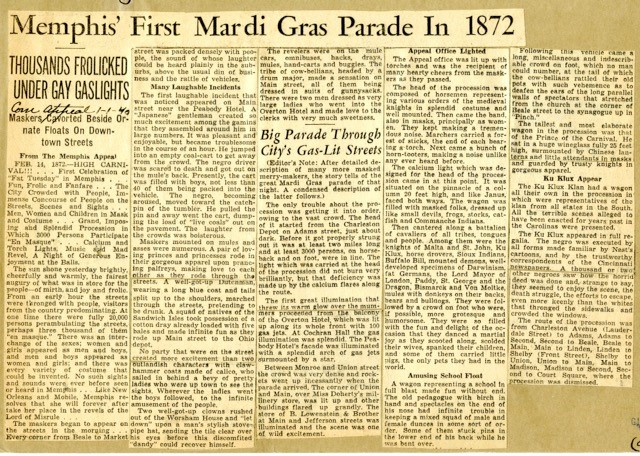By John Branston
Dateline: PASS CHRISTIAN
Here on the Mississippi gulf coast we are headed full speed to the climax of the month-long celebration of Mardi Gras, which is French for “Fat February” (also sometimes called “Fat March” or “Fat Tuesday” depending on your calendar preference, the date of Easter, the phases of the moon, and the alignment of Jupiter and Mars).
From Mobile to Pascagoula to Biloxi to Bay St. Louis to New Orleans (known as “La Mardi Pardi Central”), the parades, colorful costumes, sporadic religious observances, masked balls, unmasked balls, and cakes stuffed with sweet cream filling and odd bits of plastic are going on everywhere.
 How Memphis missed this bacchanalia (Latin for “festivities”) is one for Ripley’s. “The Gras,” as locals call it in my adopted home town Pass Christian, Miss., has so many things that fit perfectly with Memphis, including some actual history.
How Memphis missed this bacchanalia (Latin for “festivities”) is one for Ripley’s. “The Gras,” as locals call it in my adopted home town Pass Christian, Miss., has so many things that fit perfectly with Memphis, including some actual history.
For instance, the word “Krewe” — a made-up word translated as “hard-partying dudes in costumes” – may be familiar to Memphians of a certain social strata. “Carnival” Memphis (sometimes spelled “Memphi” by krewemen) is short for Cotton Carnival, a Mardi Gras knockoff staged annually in Memphis long ago in the 20th Century when cotton was king and fancy barges landed at the downtown cobblestones and, to great celebration, unloaded royalty to the adoring masses, or at least the white masses. Rumor has it secret societies still exist, and occasionally there are sightings of green-garbed “scarabs” which is French for “young hard partiers on a flatbed truck.”
This is but a taste of what full blown Mardi Gras Memphis 2.0 could be like. Memphis has been there before. In 1872 the Memphis Appeal headlined a “grand, imposing and splendid procession” in which 3,000 persons cavorted En Masque (French expression?) in the first Mardi Gras parade.
In Lords of Misrule, author James Gill of New Orleans wrote about the colorful shenanigans of Mardi Gras kings Rex and Comus and their followers fresh from the Civil War in a production called “The Missing Links to Darwin’s Origin of the Species” depicting President Grant as a tobacco grub and Darwin as “the Sapient Ass.”
But you can’t keep a good party on the down low forever. As Carnival historian Errol Laborde writes in “Chronicles of the New Orleans Carnival,” women, Blacks, and gays found a place in the festivities as The Pussyfooters, the Muff-A-Lottas, the Rolling Elvi, Zulu, the Lords of Leather, the DIVAS and the Krewe of Muses. Less successful were family-friendly stylings which learned, like certain casinos, that this ain’t a family business.
The Power of The Party was clearly demonstrated in 2006 when, six months after Katrina, Mardi Gras was held on schedule. Celebrities have sashayed and floated in costume including Drew Brees and Will Ferrell and Harry Connick, Jr.
The colors have stayed the same over the years — green, gold, and purple — but nobody seems to know exactly how or why. One theory posits the connection to LSU, but the Tigers don’t wear green, the color favored by local rival Tulane. So it goes.
The advent of the internet, YouTube, Instagram and anyone-can-record-anything suited The Gras perfectly.
Spinoffs and adaptations are welcome. In his doctoral dissertation on the New Orleans Mardi Gras, William John Koolsbergen gives a shoutout to Pass Christian for its deux Krewe fundraiser with two potential kings competing to raise the most money.
So there you have it, in broad strokes.
What is Memphis waiting for? Food, festivity, parties, flambeau, naughty costumes, controversy, parades, bands, secrecy, misinformation, frauds, villains, celebrity kings (Ja and Elvi?) …
If that don’t fetch them, I don’t know Memphis.
**
Thanks to G. Wayne Dowdy, archivist at Memphis Public Library and Information Center, for the picture of the Memphis Appeal
***
John Branston covered Memphis as a reporter and columnist for 35 years.
*****
Join the Smart City Memphis blog on its Facebook page and on Instagram to read more posts, articles, and reports relevant to Memphis.




